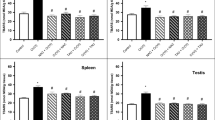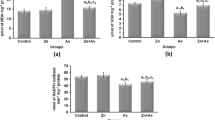Abstract
Few studies have investigated the association between essential trace elements and oxidative stress in environmental media and populations with endemic arsenism caused by coal burning. Element contents and oxidative stress indicators were measured. Moreover, the expression of genes related to the nuclear factor E2-related factor 2 (Nrf2)/Kelch-like ECH-associated protein 1 (Keap1)-antioxidant response element (ARE) signaling pathway and Nrf2-ARE binding ability is detected. The results show that the contents of arsenic, copper, iron, and chromium were increased in environmental media from the arsenism area compared with the control area; however, the selenium content decreased. The arsenic, iron, chromium, and copper contents and the copper/zinc ratio were also increased in the arsenic-exposed population; however, the selenium content decreased. The results also show that the concentrations of arsenic, iron, and chromium and the copper/zinc ratio increased gradually with the severity of arsenism. However, selenium concentrations decreased gradually with the severity of arsenism. The contents of malondialdehyde, 8-hydroxyldeoxyguanosine, and protein carbonyl in plasma increased, while the levels of sulfhydryl, thioredoxin reductase (TrxR), glutathione peroxidase (Gpx), and superoxide dismutase 1 (SOD1) decreased. The mRNA expression of Keap1 and TrxR1 decreased in the blood, while the mRNA expression of Nrf2, GPx1, and SOD1 increased. Moreover, the Nrf2 protein content and Nrf2-ARE binding ability increased, and the Keap1 protein content decreased. In conclusion, our data suggest that the increased arsenic content in environmental media and populations was accompanied by abnormal levels of essential trace elements. Insufficient selenium intake, copper, and chromium overload and a high copper/zinc ratio might be some of the causes of arsenism, which might be related to the Nrf2/Keap1-ARE signaling pathway.






Similar content being viewed by others
References
Singh AP, Goel RK, Kaur T (2011) Mechanisms pertaining to arsenic toxicity. Toxicol Int 18:87–93. https://doi.org/10.4103/0971-6580.84258
Li J, Ma L, Wang XL, Li DC, Zeng QB, Xing XM, Li CG, Xie L, Chen L, Chen W, Zhang AH (2016) Modifications of H3K9me2, H3K36me3 and H4K20me2 may be involved in arsenic-induced genetic damage. Toxicol Res 5:1380–1387
Zeng QB, Luo P, Gu JY, Liang B, Liu QZ, Zhang AH (2017) PKCθ-mediated Ca2+/NF-AT signalling pathway may be involved in T-cell immunosuppression in coal-burning arsenic-poisoned population. Environ Toxicol Pharmacol 55:44–50. https://doi.org/10.1016/j.etap.2017.08.005
Liu J, Zheng BS, Aposhian HV, Zhou YS, Chen ML, Zhang AH, Waalkes MP (2002) Chronic arsenic poisoning from burning high-arsenic-containing coal in Guizhou, China. Environ Health Perspect 110:119–122. https://doi.org/10.1289/ehp.02110119
Li DS, An D, Zhou YS, Liu J, Waalkes MP (2006) Current status and prevention strategy for coal-arsenic poisoning in Guizhou, China. J Health Popul Nutr 24:273–276
Zhang AH, Hong F, Yang GH, Pan XL, Jiang XY, Huang XX, Dong XX, Yang DP, Xie YX, Luo P, Luo P, Li J, Hu CJ, Wang XL (2007a) Unventilated indoor coal-fired stoves in Guizhou province, China: cellular and genetic damage in villagers exposed to arsenic in food and air. Environ Health Perspect 115:653–658. https://doi.org/10.1289/ehp.9272
Xiao TT, Zhang AH, Wang ZY, Wang SL (2011) Effects of toxic trace elements on arsenic poisoning caused by coal-burning. Chin J Public Health 27:305–307. https://doi.org/10.11847/zgggws2011-27-03-23
Xiao TT, Zhang AH, Wang ZY, Wang SL (2010) Relationship between coal burning type of arsenic poisoning and essential trace elements. Chin J Endemiol 29:496–499. https://doi.org/10.3760/cma.j.issn.1000-4955.2010.05.008
Dodson M, Redmann M, Rajasekaran NS, Darley-Usmar V, Zhang J (2015) Keap1-Nrf2 signalling and autophagy in protection against oxidative and reductive proteotoxicity. Biochem J 469:347–355. https://doi.org/10.1042/BJ20150568
Reszka E, Wieczorek E, Jablonska E, Janasik B, Fendler W, Waowicz W (2015) Association between plasma selenium level and NRF2 target genes expression in humans. J Trace Elem Med Biol 30:102–106. https://doi.org/10.1016/j.jtemb.2014.11.008
Hu Y, Yu C, Yao ML, Wang L, Liang B, Zhang BX, Huang XX, Zhang AH (2018) The PKCδ-Nrf2- ARE signalling pathway may be involved in oxidative stress in arsenic-induced liver damage in rats. Environ Toxicol Pharmacol 62:79–87. https://doi.org/10.1016/j.etap.2018.05.012
Vidhyasagar V, He Y, Guo M, Talwar T, Singh RS, Yadav M, Katselis G, Vizeacoumar FJ, Lukong KE, Wu Y (2018) Biochemical characterization of INTS3 and C9ORF80, two subunits of hNABP1/2 heterotrimeric complex in nucleic acid binding. Biochem J 475:45–60. https://doi.org/10.1042/BCJ20170351
Xu YY, Huang H, Zeng QB, Yu C, Yao ML, Hong F, Luo P, Pan XL, Zhang AH (2017) The effect of elemental content on the risk of dental fluorosis and the exposure of the environment and population to fluoride produced by coal-burning. Environ Toxicol Pharmacol 56:329–339. https://doi.org/10.1016/j.etap.2017.10.011
Li L, Wen B, Zhang XL, Zhao Y, Duan Y, Song XF, Ren S, Wang YH, Fang WP, Zhu XJ (2018) Geographical origin traceability of tea based on multi-element spatial distribution and the relationship with soil in district scale. Food Control 90:18–28. https://doi.org/10.1016/j.foodcont.2018.02.031
Wang B, Zhu YB, Pang YM, Xie J, Hao YX, Yan HN, Li ZW, Ye RW (2018) Indoor air pollution affects hypertension risk in rural women in Northern China by interfering with the uptake of metal elements: a preliminary cross-sectional study. Environ Pollut 240:267–272. https://doi.org/10.1016/j.envpol.2018.04.097
Kalashnikov V, Zajcev A, Atroshchenko M, Miroshniko S, Frolov A, Zav'yalov O, Kalinkova L, Kalashnikova T (2018) The content of essential and toxic elements in the hair of the mane of the trotter horses depending on their speed. Environ Sci Pollut Res 25:21961–21967. https://doi.org/10.1007/s11356-018-2334-2
Reiss B, Simpson CD, Baker MG, Stover B, Sheppard L, Seixas NS (2016) Hair manganese as an exposure biomarker among welders. Ann Occup Hyg 60:139–149. https://doi.org/10.1093/annhyg/mev064
Zhang AH (2005) Application and prospect of biomarkers in the study of endemic arsenism. Chin J Endemiol 24:119–120. https://doi.org/10.3760/cma.j.issn.1000-4955.2005.02.001
Shoeibi S, Mozdziak P, Golkar-Narenji A (2017) Biogenesis of selenium nanoparticles using green chemistry. Top Curr Chem 375:88. https://doi.org/10.1007/s41061-017-0176-x
Mariano D, de Souza D, Meinerz DF, Allebrandt J, de Bem AF, Hassan W, Rodrigues O, da Rocha J (2017) The potential toxicological insights about the anti-HIV drug azidothymidine-derived monoselenides in human leukocytes: toxicological insights of new selenium-azidothymidine analogs. Hum Exp Toxicol 36:910–918. https://doi.org/10.1177/0960327116674529
Jahid AM, Shilpa G, Navneet K, Shuchi S, Inderjit S, Harsh N (2012) Selenium antagonises the toxic effects of arsenic on mungbean (Phaseolus aureus Roxb.) plants by restricting its uptake and enhancing the antioxidative and detoxification mechanisms. Environ Exp Bot 77:242–248. https://doi.org/10.1016/j.envexpbot.2011.12.001
Kiran K, Flora SJ (2005) Strategies for safe and effective therapeutic measures for chronic arsenic and lead poisoning. Occup Health 47:1–21. https://doi.org/10.1539/joh.47.1
Mousa SA, O'Connor L, Rossman TG, Block E (2007) Pro-angiogenesis action of arsenic and its reversal by slenium-derived compounds. Carcinogenesis 28:62–967. https://doi.org/10.1093/carcin/bgl229
Wei WQ, Abnet CC, Qiao YL, Dawsey SM, Dong ZW, Sun XD, Fan JH, Gunter EW, Taylor PR, Mark SD (2004) Prospective study of serum selenium concentrations and esophageal and gastric cardia cancer, heart disease, stroke, and total death. Am J Clin Nutr 79:180–185. https://doi.org/10.1093/ajcn/79.1.80
Shweta S, Judit S (2012) Dietary selenium fortification: a potential solution to chronic arsenic toxicity. Toxicol Environ Chem 94:1453–1465. https://doi.org/10.1080/02772248.2012.701104
Kutrowska A, Małecka A, Piechalak A, Masiakowski W, Hanć A, Barałkiewicz D, Andrzejewska B, Zbiersk J, Tomaszewska B (2017) Effects of binary metal combinations on zinc, copper, cadmium and lead uptake and distribution in Brassica juncea. J Trace Elem Med Biol 44:32–39. https://doi.org/10.1016/j.jtemb.2017.05.007
Gnogbo AB, Lydie B, Souleymane M, Gervais MM, Kadjowely Y, Kouassi RN, Alain DPB, Allico JD (2017) Assessments of serum copper and zinc concentration, and the Cu/Zn ratio determination in patients with multidrug resistant pulmonary tuberculosis (MDR-TB) in Côted’Ivoire. BMC Infect Dis 17:257. https://doi.org/10.1186/s12879-017-2343-7
Mousavi SN, Faghihi A, Motaghinejad M, Shiasi M, Imanparast F, Amiri HL, Shidfar F (2018) Zinc and selenium co-supplementation reduces some lipid peroxidation and angiogenesis markers in a rat model of NAFLD-fed high fat diet. Biol Trace Elem Res 181:288–295. https://doi.org/10.1007/s12011-017-1059-2
Wang X, Yin S, Yang Z, Zhou B (2018) Drosophila multicopper oxidase 3 is a potential ferroxidase involved in iron homeostasis. Biochim Biophys Acta Gen Subj 1862:1826–1834. https://doi.org/10.1016/j.bbagen.2018.04.017
Shi F, Zhang P, Mao Y, Wang C, Zheng M, Zhao Z (2017) The nitroxide Tempo inhibits hydroxyl radical production from the Fenton-like reaction of iron(II)-citrate with hydrogen peroxide. Biochem Biophys Res Commun 483:159–164. https://doi.org/10.1016/j.bbrc.2016.12.174
Su WL, Cheng CC, Shia WY, Hsu TH, Chen KS, Wang HC, Lee WM (2016) Effect of trivalent chromium on growth hormone and insulin-like growth factor-I in ovariohysterectomized rats. Taiwan Vet J 42:159–163. https://doi.org/10.1142/s1682648515500262
Abreu PL, Cunha OT, Ferreira LMR, Urbano AM (2018) Hexavalent chromium, a lung carcinogen, confers resistance to thermal stress and interferes with heat shock protein expression in human bronchial epithelial cells. Biometals 31:477–487. https://doi.org/10.1007/s10534-018-0093-7
Całyniuk B, Grochowska-Niedworok E, Walkiewicz KW, Kawecka S, Popiołek E, Fatyga E (2016) Malondialdehyde (MDA)-product of lipid peroxidation as marker of homeostasis disorders and aging. Ann Acad Med Silesiensis 70:224–228. https://doi.org/10.18794/aams/65697
Santos C, Pires MDA, Santos D, Payan-Carreira R (2016) Distribution of superoxide dismutase 1 and glutathione peroxidase 1 in the cyclic canine endometrium. Theriogenology 86:738–748
Guo C, Li XF, Wang R, Yu JK, Ye MF, Mao LN, Zhang SZ, Zheng S (2016) Association between oxidative DNA damage and risk of colorectal cancer: sensitive determination of urinary 8-hydroxy-2′-deoxyguanosine by UPLC-MS/MS analysis. Sci Rep 6:32581. https://doi.org/10.1038/srep32581
Fernando N, Wickremesinghe S, Niloofa R, Rodrigo C, Karunanayake L, de Silva HJ, Wickremesinghe AR, Premawansa S, Rajapakse S, Handunnetti SM (2016) Protein carbonyl as a biomarker of oxidative stress in severe leptospirosis, and its usefulness in differentiating leptospirosis from dengue infections. PLoS One 11:e0156085. https://doi.org/10.1371/journal.pone.0156085
Fetherolf MM, Boyd SD, Taylor AB, Kim HJ, Wohlschlege JA, Blackburn NJ, Hart PJ, Winge DR, Winkler DD (2017) Copper-zinc superoxide dismutase is activated through a sulfenic acid intermediate at a copper ion entry site. J Biol Chem 292:12025–12040. https://doi.org/10.1074/jbc.M117.775981
Enrico L, Letizia B, Lucia B (2017) A molecular chaperone activity of CCS restores the maturation of SOD1 fALS mutants. Sci Rep 7:17433. https://doi.org/10.1038/s41598-017-17815-y
Wang J, Shanmugam A, Markand S, Zorrilla E, Ganapathy V, Smith SB (2015) Sigma 1 receptor regulates the oxidative stress response in primary retinal Müller glial cells via Nrf2 signaling and system xc(-), the Na(+)-independent glutamatecystine exchanger. Free Radic Biol Med 86:25–36. https://doi.org/10.1016/j.freeradbiomed.2015.04.009
Vnukov VV, Gutsenko OI, Milutina NP, Ananyan AA, Danilenko AO, Panina SB, Kornienko IV (2015) Influence of SkQ1 on expression of Nrf2 transcription factor gene, ARE-controlled genes of antioxidant enzymes and their activity in rat blood leukocytes. Biochemistry 80:586–591. https://doi.org/10.1134/S0006297915050107
Acknowledgments
We thank the anonymous reviewers for valuable comments on the manuscript.
Funding
This work was supported by the National Natural Science Foundation of China (grant nos. 81430077 and 81172603).
Author information
Authors and Affiliations
Corresponding author
Ethics declarations
Written informed consent was obtained from all participants. The study proposal was reviewed and approved by the Ethical Committee of Guizhou Medical University.
Conflict of Interest
The authors declare that they have no conflict of interest.
Additional information
Publisher’s Note
Springer Nature remains neutral with regard to jurisdictional claims in published maps and institutional affiliations.
Rights and permissions
About this article
Cite this article
Hu, Y., Xiao, T., Wang, Q. et al. Effects of Essential Trace Elements and Oxidative Stress on Endemic Arsenism Caused by Coal Burning in PR China. Biol Trace Elem Res 198, 25–36 (2020). https://doi.org/10.1007/s12011-020-02047-5
Received:
Accepted:
Published:
Issue Date:
DOI: https://doi.org/10.1007/s12011-020-02047-5




